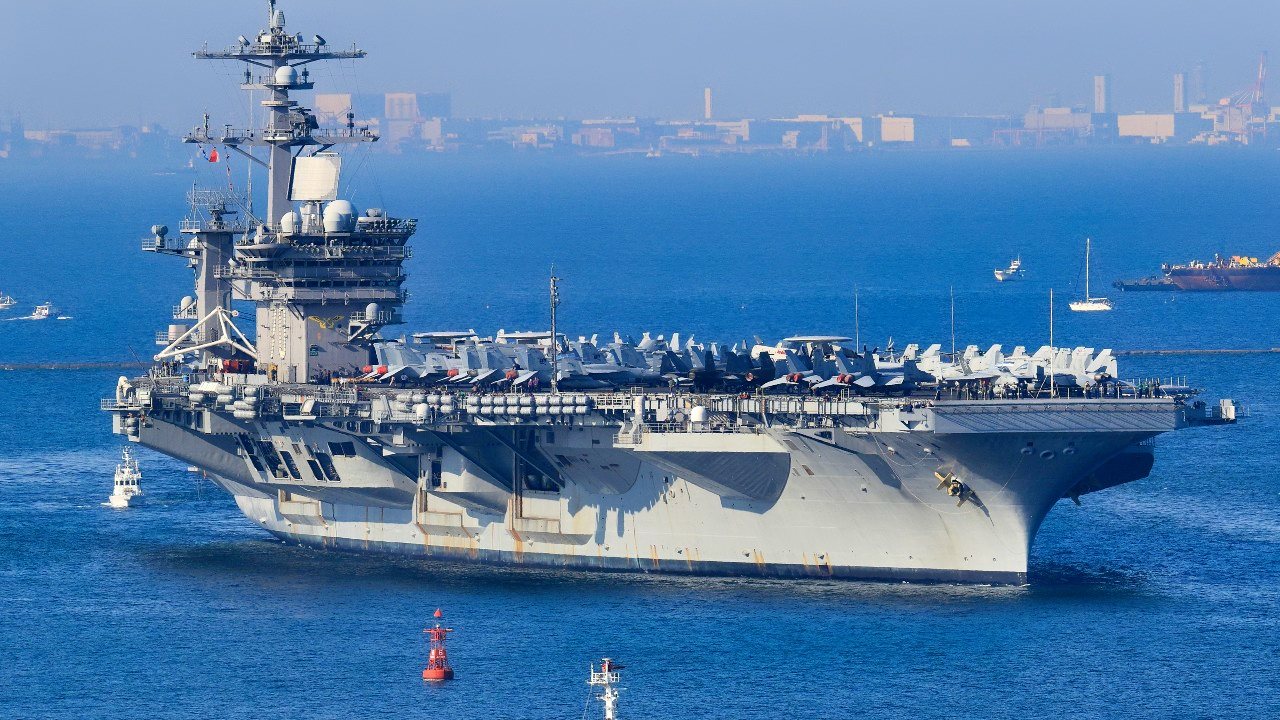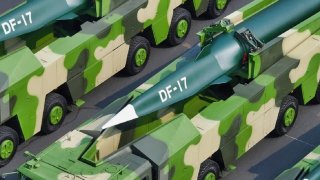China's Dangerous DF-17 Hypersonic Missile Can Hit U.S. Bases and Aircraft Carriers
A year ago, a report from the Pentagon warned that China's Dong Feng-17 (DF-17) hypersonic glide vehicle (HGV)-powered medium-range ballistic missile (MRBM) had been designed to strike foreign military bases and fleets in the Western Pacific.
A year ago, a report from the Pentagon warned that China's Dong Feng-17 (DF-17) hypersonic glide vehicle (HGV)-powered medium-range ballistic missile (MRBM) had been designed to strike foreign military bases and fleets in the Western Pacific.
The DF-17 was among the platforms specifically called out in the U.S. Department of Defense's (DoD's) 2022 China Military Power Report (CMPR), and further noted that it could replace some of Beijing's older short-range ballistic missile (SRBM) units."
"The DF-17 passed several tests successfully and is deployed operationally. While the DF-17 is primarily a conventional platform, it may be equipped with nuclear warheads," the Pentagon's report stated, while it further cautioned that the DF-17 could also be impervious to U.S. air-defense systems, such as the "THAAD [Terminal High Altitude Area Defense], SM-3 [Standard Missile-3], and Patriot" missile systems.
This year's 2023 Report on the Military and Security Developments Involving the People's Republic of China further noted, "The PRC's deployment of the DF-17 HGV-armed MRBM will continue to transform the PLA's missile force. The system is possibly intended to replace some older SRBM units and is intended to strike foreign military bases and fleets in the Western Pacific, according to a PRC-based military expert."
DF-17: A Hypersonic Glide Vehicle Explained
The DF-17 is the first missile designed for the operational deployment of a HGV by the People's Liberation Army Rocket Force (PLARF). U.S. officials first confirmed the existence of the DF-17 prototypes in January 2014 – and it was initially identified as the Wu-14 – while the Pentagon had monitored at least nine flight tests through November 2017. Tests took place at the Taiyuan Satellite Launch Centre in Shanxi Province.
China's 10th Research Institute is reported to have been responsible for developing the DF-17 along with other Chinese HGVs. Also known as the "Near Space Flight Vehicle Research Institute," the organization operates under the China Aerospace Science Industry Corporation (CASIC) 1st Academy.
The DF-17 was first noted in a PLA parade in October 2019 and is believed to have entered service in 2020.
"Although HGVs are slower than conventional ballistic reentry vehicles, their higher maneuverability and lower-altitude flight allow them to evade missile defense systems as their flight paths are harder to predict. U.S. officials have stated that the prototypes have been shown to perform 'extreme maneuvers' and 'evasive actions," the Missile Defense Advocacy Alliance (MDAA) reported, adding, "The DF-17 is a vital weapon in China's arsenal, as it provides the PLARF with a missile that is highly capable against existing missile defenses and sensors. With its range, the DF-17 could reach South Korea and Japan, challenging their missile defense systems."
Key DF-17 Facts
The DF-17 is a solid-fuelled road-mobile medium-range ballistic missile, and it measures around 11 meters (36 feet) in length and weighs around 15,000 kg. According to Army Recognition, the DF-17 missile is mounted on 10x10 military truck chassis with two axles at the front and three axles at the rear. The truck chassis is used as a TEL (Transporter Erector Launcher), which can carry, elevate to the firing position, and launch one or more missiles. The front of the truck is equipped with a crew cab with two doors on each side. The truck is reported to be powered by a diesel engine developing 500 to 600 hp and can reach a top speed of 70 km/h with a maximum cruising range of 650 km.
The DF-17's booster is believed to same as that used for China's DF-16 ballistic missile. Its accompanying DF-ZF HGV reportedly reaches speeds of Mach 5-10 (1.72-3.43 km/s) in its glide phase, while it is believed to have a range between 1,250 to 1,800 km (780–1,120 miles) – with some sources suggesting it could be as great as 2,500 km (1,550 miles). It may be armed with conventional or nuclear warheads.
Due to the use of a HGV instead of a conventional reentry vehicle, there has been speculation that the DF-17 could be employed to target U.S. Navy aircraft carriers operating within its effective range. While Beijing's Anti-ship Ballistic Missiles, notably the DF-21D, employ conventional reentry vehicles, which, although faster than HGVs, are less maneuverable.

As they enter service in greater numbers, it is entirely possible (and even likely) that the DF-17 and DF-ZF will be used in a land-attack role alongside an anti-ship role.
U.S. Lawmakers Have Been Warned
In March, the threat of the DF-17 and similar weapons was brought before members of Congress.
"While both China and Russia have conducted numerous successful tests of hypersonic weapons and have likely fielded operational systems, China is leading Russia in both supporting infrastructure and numbers of systems," Paul Freisthler, the Defense Intelligence Agency's chief scientist for science and technology, told U.S. lawmakers.

"Over the past two decades, China has dramatically advanced its development of conventional and nuclear-armed hypersonic missile technologies and capabilities through intense and focused investment, development, testing and deployment," said Friesthler while testifying in front of the House Armed Services Committee.
The Pentagon understands the very serious threat that the DF-17 poses, but it remains unclear how it might respond.
Author Experience and Expertise
Peter Suciu is a Michigan-based writer. He has contributed to more than four dozen magazines, newspapers, and websites with over 3,200 published pieces over a twenty-year career in journalism. He regularly writes about military hardware, firearms history, cybersecurity, politics, and international affairs. Peter is also a Contributing Writer for Forbes and Clearance Jobs. You can follow him on Twitter: @PeterSuciu.
All images are Creative Commons.


